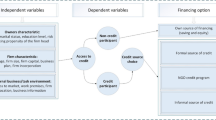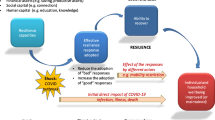Abstract
This paper explores the efficacy of a development model designed to enhance social capital where social capital is seen as a catalyst to increased economic opportunities. The study covers smallholder livestock producers in Malawi and the Philippines. The key question examined in this paper is whether communities that received this specific development intervention significantly increased their access to social capital over time and whether this social capital is positively correlated with net farm income and improved livelihoods. We draw data from two case studies: Heifer International’s Malawi Smallholder Dairy Development Project (MSDD1) and the Philippine Raising Income of Families through Sustainable Agri-Business Project (RICSA). The examination of these two cases increases our understanding of how implementation and contextual variables may influence changes in social capital and livelihoods. The study applies social network analysis (SNA) to understand the connection between asset-based/human capacity interventions and social capital. SNA provides a quantitative measure of networks and households’ position within those networks as indicators of social capital. Real net income which includes the value of home consumption is used as a proxy for ‘improved livelihoods.’ A quasi-experimental design is used to determine whether social capital and income variables change significantly over time and whether social capital is correlated with income. The results revealed significant differences across the two cases. In the Malawi case, the intervention significantly contributed to social capital formation. In the Philippine case study, the social capital did not demonstrate a significant difference. The dissimilarity between the two cases shows that it takes time to deepen bonds of trust and reciprocity and to extend networks as conduits of knowledge, information and economic opportunity.


Similar content being viewed by others
Notes
Income is calculated as net farm income which includes the value of home consumption of food produced by the household. This inclusion allows the term livelihood to in include a key component of food security.
Since social capital is difficult to measure as a tangible form of capital, we are using social network centrality measures as an indicator of social capital.
Households that receive a calf from an original group (OG) are selected by the participants and must have gone through sufficient training to be prepared to care for the animal.
Program theory refers to the assumptions on which the program design was based.
We use the term livelihood to not only include direct income but also provide an economic value to increased food production consumed or shared by the households.
Missing or incomplete markets exist when goods and services are not exchanged because there is no formalized market, that is, the absence of arm’s length transactions.
For other contextual factors that may have an influence on project outcomes, see the above discussions.
References
Barrientos A (2012) Social transfers and growth: what do we know? What do we need to find out? World Dev 40(1):11–20
Baycan T (2018) The dark side of social capital. In Workshop US & Turkey scientific collaboration programme 2223D—the role of social Capital Inrural development: examples from Turkey and The World, March 22–23, İzmir
Claridge T (2018) Dimensions of social capital—structural, cognitive and relational. Social Capital research, Dunedin, NZ
Cleaver F (2005) The inequality of social capital and the reproduction of chronic poverty. World Dev 33:893–906
Dasgupta P, Serageldin I (2000) Social capital: a multifaceted perspective. World Bank, Washington DC
De Blasio G, Nuzzo G (2012) Social capital and inequality in Italy. Bank of Italy Occasional Paper No. 116
De Hert T, Deneulin S (2007) Guest Edıtors’ Introduction. J Hum Dev Capab 8(2):179–184
Fitzpatrick E, Akgüngör S (2019) Evaluating the asset transfer model in facilitating sustainable livelihoods in rural Malawi. Economia Agri Alimentare-Food Econ, FrancoAngeli Editore 2019(1):129–152
Granovetter M (1992) Economic institutions as social constructions: a framework for analysis. Acta Sociol 35(1):3–11
Hartmann D, Arata A (2011) Measuring social capital and innovation in poor agricultural communities: The case of Chaparra Peru. Forschungszentrum Innovation und Dienstleistung (FZID) Discussion Paper No:30-2011. Universitat Hohenheim, Forschungszentrum Innovation und Dienstleistung (FZID), Stuttgart
Hartmann E, Herb S (2014) Opportunism risk in service traids—a social capital perspective. Int J Phys Distrib Logist Manag 44(3):242–256
Haushofer J, Shapiro J (2013) Welfare effects of unconditional cash transfers: pre-analysis plan. Princeton University Joha Publications. http://www.princeton.edu/joha/publications/Haushofer_Shapiro_UCT_Analysis_Plan_2013.pdf. Accessed May 2018
Heifer International Malawi (2012) Final report for Malawi smallholder diary development project, January 1, 2007–May 31, 2012. https://pdf.usaid.gov/pdf_docs/pdacy169.pdf. Accessed May 2018
Jaimovich N, Gervais M, Siu H, Levi Y (2015) Technological learning and labor market dynamics. Int Econ Rev 56(1):27–53
Krishna A, Poghosyan M, Das N (2012) How much can asset transfers help the poorest? Evaluating the results of BRAC’s ultra poor programme (2002–2008). J Dev Stud 48(2):254–267
Lin N (2005) A network theory of social capital. In: Castiglione D, Deth J, Wolleb G (eds) Handbook on social capital. Oxford Universtiy Press, Oxford
Morgan A, Ziglio E (2007) Revitalising the evidence base for public health: an assets model global health promotion. IUHPE Promot Educ 2:17–22
Murdock TB (2000) Incorporating economic context into educational psychology: methodological and conceptional challenges. Educational Psychologist 35(2):113–124
Putnam R (2001) Social capital: measurement and consequences. Can J Policy Res 2:41–51
Robison L, Oliver J (2019) Rationalizing predictably irrational choices: the social capital synthesis. Ann Reg Sci. https://doi.org/10.1007/s00168-019-00945-8
Robison L, Schimid A, Siles ME (2002) Is social capital really capital. Review of Social Economy 60(1):1–21
Spielman D, Davis K, Negash M, Ayele G (2011) Rural innovation systems and networks: findings from a study of ethiopian smallholders. Agric Hum Values 28(2):195–212
Tregear A, Cooper S (2016) Embeddesness, social capital and learning in rural areas: the case of producer cooperatives. J Rural Stud 4:101–110
Woolcock M (2000) Social capital: implications for development theory, research and policy. World Bank Res Obs 15(2):225–249
Author information
Authors and Affiliations
Corresponding author
Additional information
Publisher's Note
Springer Nature remains neutral with regard to jurisdictional claims in published maps and institutional affiliations.
Rights and permissions
About this article
Cite this article
Fitzpatrick, E., Akgungor, S. The contribution of social capital on rural livelihoods: Malawi and the Philippines cases. Ann Reg Sci 70, 659–679 (2023). https://doi.org/10.1007/s00168-020-01005-2
Received:
Accepted:
Published:
Issue Date:
DOI: https://doi.org/10.1007/s00168-020-01005-2




